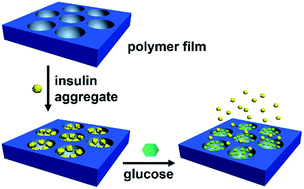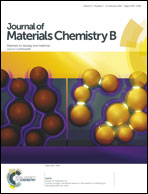A patterned porous polymer film for localized capture of insulin and glucose-responsive release†
Abstract
A glucose-responsive, porous polymer film which can be used for controlled insulin release was fabricated. By mixing a polystyrene–dichloromethane solution containing didodecylamine with water, with thorough shaking, a reverse microemulsion was achieved. After spreading the microemulsion on a glass slide and evaporating the solvent, an ordered honeycomb-patterned film was produced, accompanied by an accumulation of didodecylamine within the inner surface of the cavities. The patterned cavities were further modified with poly(acrylic acid), 3-aminophenylboronic acid, and alginate so that they would entrap insulin aggregates. The insulin aggregates were prepared using a salting-out method and were incorporated into the cavities by an electrostatic interaction with the alginate. Under the stimulus of glucose, insulin aggregates were released from the cavities and further calculations demonstrated that there was a very high efficiency of release. In contrast, in an aqueous solution without glucose, almost no insulin was released from the cavities. This investigation demonstrates that it is feasible for porous polymer films, whose cavities act as a protein reservoir, to be used as a glucose-responsive insulin delivery vehicle, which may have potential as a controlled-release drug-delivery system for the treatment of diabetes.


 Please wait while we load your content...
Please wait while we load your content...